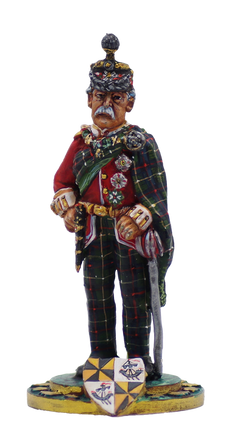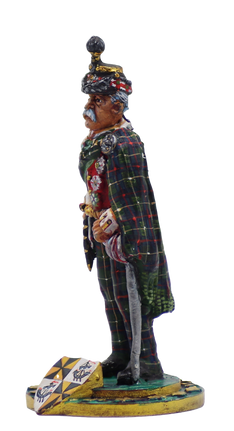
John Campbell
Duke of Argyll
John George Edward Henry Douglas Sutherland Campbell, 9th Duke of Argyll (6 August 1845 – 2 May 1914), usually better known by the courtesy title Marquess of Lorne, by which he was known between 1847 and 1900, was a British nobleman who was Governor General of Canada from 1878 to 1883. He was the husband of Princess Louise, fourth daughter of Queen Victoria. He was the first president of "Rangers Football Club", thanks to his Argyll ties to the original founders of the football club. Campbell was born in London, the eldest son
of George, Marquess of Lorne and the former Lady Elizabeth Sutherland-Leveson-Gower, daughter of the 2nd Duke of Sutherland, and was styled Earl of Campbell from birth. In 1847, when he was 21 months old, his father succeeded as 8th Duke of Argyll and he assumed the courtesy title Marquess of Lorne, which he bore until he was 54. He was educated at Edinburgh Academy, Eton College, St Andrews and at Trinity College, Cambridge, as well as at the National Art Training School. For ten years before coming to Canada, Lorne travelled throughout North and Central America, writing travel literature and poetry. In the

UK, he represented, from 1868, the constituency of Argyllshire as a Liberal Member of Parliament in the House of Commons. He was appointed Lieutenant-Colonel Commandant of the part-time 1st Argyll and Bute Artillery Volunteers on 13 July 1866. He gave up the position in the 1880s, but was appointed the unit's Honorary Colonel on 18 July 1900. Lord Lorne married Queen Victoria's fourth daughter, Princess Louise, on 21 March 1871. This was the first time a legitimate daughter of the sovereign had married a subject of the Crown since 1515, when Charles Brandon, the first Duke of Suffolk, married Mary Tudor. The pair shared a common love of the arts, but the marriage was childless and unhappy, and they spent much time apart. When Lord Lorne's appointment was announced, there was great excitement throughout Canada. For the first time, Rideau Hall would have a royal resident. The Canadian Prime Minister relaxed his busy campaign schedule to prepare for her arrival and to organise a special carriage and corps of guards to protect the Princess. An author wrote in 1880 that "the appointment was hailed with satisfaction in all parts of the Dominion, and the new Governor General entered upon his term of office with the hearts of the people strongly prepossessed in his favour." At age 33, Lord Lorne was Canada's youngest governor general and he became the first representative of Queen Victoria to have been born during the latter's reign but he was not too young to handle the marginal demands of his post. He and Princess Louise made many lasting contributions to Canadian society, especially in the arts and sciences. They encouraged the establishment of the Royal Society of Canada, the Royal Canadian Academy of Arts, and the National Gallery of Canada, even selecting some of its first paintings. Campbell was involved in the completion of the Canadian Pacific Railway and other projects, such as a hospital for British Columbia. Throughout his term of office, Lorne was intensely interested in Canada and Canadians. He travelled throughout the country, encouraging the establishment of numerous institutions, and met with First Nations and other Canadians from all walks of life. At Rideau Hall, he and Princess Louise hosted many social functions, including numerous ice skating and tobogganing parties as well as balls, dinners and state occasions. His small collection of First Nations artefacts was purchased by the British Museum in 1887. Princess Louise returned to England in 1881 and Lord Lorne followed two years later in 1883, when his book, Memories of Canada and Scotland, was published. Lorne was Governor and Constable of Windsor Castle from 1892 to 1914 and he sat as MP for Manchester South from 1895 until the death of his father on 24 April 1900, when he succeeded as 9th and 2nd Duke of Argyll.

The Highland Light Infantry (HLI) was a light infantry regiment of the British Army formed in 1881. The regiment was formed as part of the Childers Reforms on 1 July 1881 by the amalgamation of the 71st (Highland) Light Infantry (as the 1st Battalion) and the 74th (Highland) Regiment of Foot (as the 2nd Battalion) as the city regiment of Glasgow, absorbing local Militia and Rifle Volunteer units. Its exact status was ambiguous: although the regiment insisted on being classified as a non-kilted Highland regiment, it recruited mainly from Glasgow in Lowland Scotland. The 1st battalion was posted to South Africa in October 1899, after the outbreak of the Second Boer War. The battalion served throughout the war, which ended in June 1902. The battalion of 700 men left Durban for Egypt on the SS Plassy in January 1903, and was subsequently stationed there in the following years. The 2nd Battalion saw action at the Battle of Tell El Kebir in September 1882 during the Anglo-Egyptian War: Lieutenant William Edwards was awarded the Victoria Cross for his actions during the battle. The battalion was stationed in England from 1883, but moved to India the following year. In February 1900 the battalion departed from Colombo to return home, and in October 1902 they were posted to Jersey, but three months later they were reassigned to Alderney. Following heavy British losses in the early part of the Second Boer War in 1899, many of
the militia battalions were embodied for active service, including the 3rd battalion Highland Light (formerly the 1st Royal Lanark Militia), under the command of Lieutenant-Colonel William Story. The battalion served throughout the war, and 890 officers and men were reported to return home on the SS Doune Castle in September 1902, after the war had ended earlier that year.

Clan Campbell (Scottish Gaelic: Na Caimbeulaich) is a Highland Scottish clan, historically one of the largest and most powerful of the Highland clans. The Clan Campbell lands are in Argyll and within their lands lies Ben Cruachan. The chief of the clan became Earl of Argyll and later Duke of Argyll. In traditional genealogies of Clan Campbell, the clan's origins are in the ancient Britons of Strathclyde. The earliest Campbell in written record is Gillespie, whose name is recorded in 1263. Early grants to Gillespie and his relations were almost all in east-central Scotland. The family's connection with Argyll came some generations earlier when a Campbell married the heiress of the O'Duines and she brought with her the Lordship of Loch Awe. Because of this, the early clan name was Clan O'Duine. The name was later styled Clann Diarmaid based on a fancied connection to Diarmuid the Boar, a great hero from early Celtic mythology. The original seat of Clan Campbell was either Innes Chonnel Castle on Loch Awe or Caisteal na Nigheann Ruaidh on Loch Avich. The clan's power soon spread throughout Argyll, though at first the Campbells were under the domination of the Lords of Lorne, chiefs of Clan MacDougall. The MacDougalls killed the Campbell chief Cailean Mór (Colin
Campbell) in 1296. All subsequent chiefs of Clan Campbell have taken MacCailean Mór as their Gaelic patronymic. Between 1200 and 1500, the Campbells emerged as one of the most powerful families in Scotland, dominant in Argyll and capable of wielding a wider influence and authority from Edinburgh to the Hebrides and western Highlands. Duke of Argyll (Scottish Gaelic: Diùc Earraghàidheil) is a title created in the peerage of Scotland in 1701 and in the peerage of the United Kingdom in 1892. The earls, marquesses, and dukes of Argyll were for several centuries among the most powerful noble families in Scotland. As such, they played a major role in Scottish history throughout the 16th, 17th, and 18th centuries. The Duke of Argyll also holds the hereditary titles of chief of Clan Campbell and Master of the Household of Scotland. Sir Colin Campbell of Lochow was knighted in 1280. In 1445 James II of Scotland raised Sir Colin's descendant Sir Duncan Campbell to the peerage to become Duncan Campbell of Lochow, Lord of Argyll, Knight, 1st Lord Campbell. Colin Campbell (c. 1433–1493) succeeded his grandfather as the 2nd Lord Campbell in 1453 and was created Earl of Argyll in 1457. The 8th Earl of Argyll was created a marquess in 1641, when Charles I visited Scotland and attempted to quell the rising political crisis (and the fall-out from the event known as The Incident). With Oliver Cromwell's victory in England, the marquess became the effective ruler of Scotland. Upon the restoration, the marquess offered his services to King Charles II but was charged with treason and executed in 1661. His lands and titles were forfeited but in 1663, they were restored to his son, Archibald, who became the 9th Earl of Argyll. In 1685 the 9th Earl was executed for his part in the Monmouth rebellion. On 21 June 1701 the 9th Earl's son was created Duke of Argyll, Marquess of Kintyre and Lorne, Earl of Campbell and Cowal, Viscount of Lochow and Glenyla, Lord Inveraray, Mull, Morvern, and Tiree for his services to William of Orange. His son, the 2nd Duke, was created Baron Chatham and Earl of Greenwich in 1705 as a reward for his support for the Act of Union and further elevated to the title Duke of Greenwich in 1719. Upon his death his Scottish titles passed to his brother and the English titles became extinct. The 5th Duke sat as a member of parliament for Glasgow Burghs until his father's accession to the Dukedom in 1761 disqualified him from representing a Scottish seat. He then became the member for Dover until 1766, when he was created Baron Sundridge and obtained the right to sit in the House of Lords. On 17 April 1892, the 8th Duke was created Duke of Argyll in the Peerage of the United Kingdom. Thus, the Duke is one of only five people to hold two or more different dukedoms, the others being the Duke of Cornwall and Rothesay, the Duke of Buccleuch and Queensberry, the Duke of Hamilton and Brandon, and the Duke of Richmond, Lennox, and Gordon.
Awards: Collar, sash and star of the Most Ancient and Most Noble Order of the Thistle, Stars of the Most Distinguished Order of Saint Michael and Saint George and the Royal Victorian Order.






